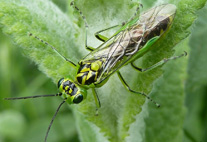Abstract
Caurinus dectes Russell (Mecoptera: Boreidae: Caurininae) was described from the central and northern Coast Range of Oregon (Russell 1979). The holotype and paratypes were collected in moist forests with abundant epiphytic and terrestrial bryophytes, and its larvae were found to be endophytophagous in liverworts (Russell 1979, 1982). This scorpionfly is so unusual it was recognized as representing a previously unknown subfamily and is unofficially known as the “Oregon funny bug”. The type locality is known amongst collectors as “Funny Bug Notch”. Recent collections of adult specimens, all by means of beating and Berlese funnel, have expanded the known range of C. dectes with new county and state records in Oregon and Washington, respectively. Two males, one each from Jefferson and Whatcom Counties in Washington, were dissected. Comparison of their genitalia with specimens from the type locality collected by one of us (JBJ) 23 November 1984 at Funny Bug Notch, on the northeast ridge of Marys Peak, Benton County, Oregon, at the 183-m (600 ft) elevation, confirmed that the specimens are C. dectes, despite most individuals from these more northerly areas being darker colored than is typical for Oregon specimens. All of the 22 new collections are from the states of Oregon and Washington, as follows.

